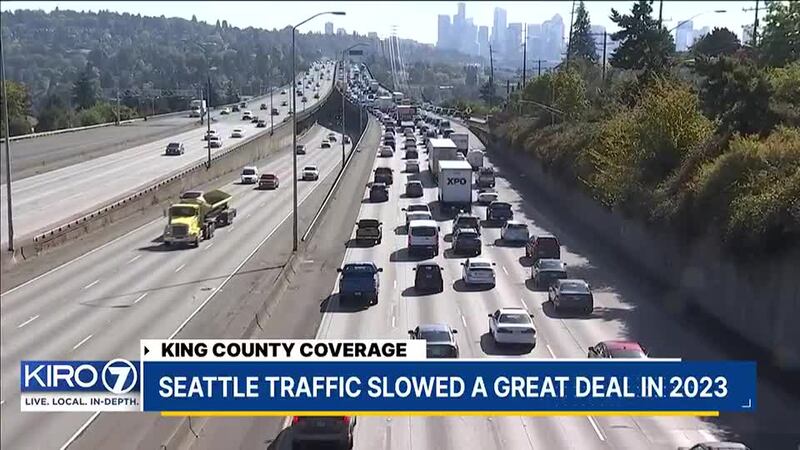SEATTLE — Drivers in the Seattle metro are hitting the brakes, but not by choice. Data from a new study found traffic in the area slowed down a lot last year.
This new data comes from Kirkland-based company INRIX, which found Seattle’s traffic is one of the worst in the U.S.
In South King County near Tukwila, commuter Anthony Martinez lamented over the condition of traffic now and for most of last year.
“(It’s) probably gotten worse,” he said.
That sentiment was echoed by another commuter, Sean McCormick, but with some optimism.
“(Bad traffic) has its days, but it’s generally not too bad,” he said.
INRIX says the slow roll in the greater Seattle area cost drivers an average of 58 hours during 2023. That’s nearly 2 and a half days.
“Seattle is ranked tenth worst in the U.S. for traffic congestion,” said INRIX transportation analyst, Bob Pishue.
Martinez feels that rank is justified.
“I feel like every morning or when I’m coming home, it gets a bit more crowded,” he said.
For INRIX, the numbers reflect a traffic trend showing people going back to offices, a trend drivers have noticed. But INRIX also says change is happening.
Traffic is no longer contained to rush hour from 7 to 8 a.m. or 5 p.m. Apparently, it’s also noon, according to Pishue.
“It looks more like a gradual buildup than peaks and valleys, if you will. Middle of the day - people are getting out and traveling - so that congestion could actually be building a lot sooner,” he said.
INRIX points out that time lost in traffic can also mean money lost in traffic.
“It’s equal to about a little over $1,000 in lost productivity,” Pishue said.
INRIX studied some of the region’s slowest spots, and while Seattle isn’t great overall with the free flow of traffic, INRIX does believe some traffic can be mitigated if employers and employees work together on remote work schedules to help cut commutes and balance out potential bottlenecks.
Pishue admits that won’t be easy, but he hopes motorists can practice patience and work with employers toward solutions.
“The number one thing is to not let it get you frustrated. It’s adjusting our habits as well. it’s employers being a part of that conversation.”
INRIX Seattle-area corridors with the most slowdowns in 2023:
- Northbound Interstate 5 from Northgate to South Everett: delayed 11.2 minutes at 4 p.m.
- Northbound I-5 from Albro Place to downtown Lynnwood: delayed 9.8 minutes at 4 p.m.
- Northbound Interstate 405, from State Route 167 to Interstate 90: delayed 9.5 minutes at 8 a.m.
- Southbound I-5 from 164th Street Southwest in north Lynnwood to Northgate: delayed 8.4 minutes at 7 a.m.
- Southbound State Route 167, from 15th Street Southwest in Auburn to Highway 410: delayed 7.9 minutes at 3 p.m.
- Northbound I-5 from the Boeing Freeway in Everett to Marysville: delayed 7.7 minutes at 4 p.m.
©2024 Cox Media Group








